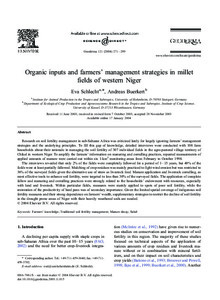| dc.date.accessioned | 2007-05-23T09:36:39Z | |
| dc.date.available | 2007-05-23T09:36:39Z | |
| dc.date.issued | 2004 | |
| dc.identifier.issn | 0016-7061 | |
| dc.identifier.uri | urn:nbn:de:hebis:34-2007052318292 | |
| dc.identifier.uri | http://hdl.handle.net/123456789/2007052318292 | |
| dc.format.extent | 332131 bytes | |
| dc.format.mimetype | application/pdf | |
| dc.language.iso | eng | |
| dc.rights | Urheberrechtlich geschützt | |
| dc.rights.uri | https://rightsstatements.org/page/InC/1.0/ | |
| dc.subject | Farmers' knowledge | eng |
| dc.subject | Traditional soil fertility management | eng |
| dc.subject | Manure decay | eng |
| dc.subject | Sahel | eng |
| dc.subject.ddc | 630 | |
| dc.title | Organic inputs and farmers' management strategies in millet fields of western Niger | eng |
| dc.type | Aufsatz | |
| dcterms.abstract | Research on soil fertility management in sub-Saharan Africa was criticized lately for largely ignoring farmers’ management strategies and the underlying principles. To fill this gap of knowledge, detailed interviews were conducted with 108 farm households about their rationale in managing the soil fertility of 307 individual fields in the agro-pastoral village territory of Chikal in western Niger. To amplify the farmers’ information on manuring and corralling practices, repeated measurements of applied amounts of manure were carried out within six 1-km^2 monitoring areas from February to October 1998. The interviews revealed that only 2% of the fields were completely fallowed for a period of 1–15 years, but 40% of the fields were at least partially fallowed. Mulching of crop residues was mainly practiced to fight wind erosion but was restricted to 36% of the surveyed fields given the alternative use of straw as livestock feed. Manure application and livestock corralling, as most effective tools to enhance soil fertility, were targeted to less than 30% of the surveyed fields. The application of complete fallow and manuring and corralling practices were strongly related to the households’ endowment with resources, especially with land and livestock. Within particular fields, measures were mainly applied to spots of poor soil fertility, while the restoration of the productivity of hard pans was of secondary importance. Given the limited spatial coverage of indigenous soil fertility measures and their strong dependence on farmers’ wealth, supplementary strategies to restrict the decline of soil fertility in the drought prone areas of Niger with their heavily weathered soils are needed. | eng |
| dcterms.accessRights | open access | |
| dcterms.bibliographicCitation | In: Geoderma. Amsterdam : Elsevier. 121.2004, H. 3, S. 271-289 | |
| dcterms.creator | Schlecht, Eva | |
| dcterms.creator | Bürkert, Andreas | |
| dc.description.everything | The original publication is available at www.elsevier.com | eng |

